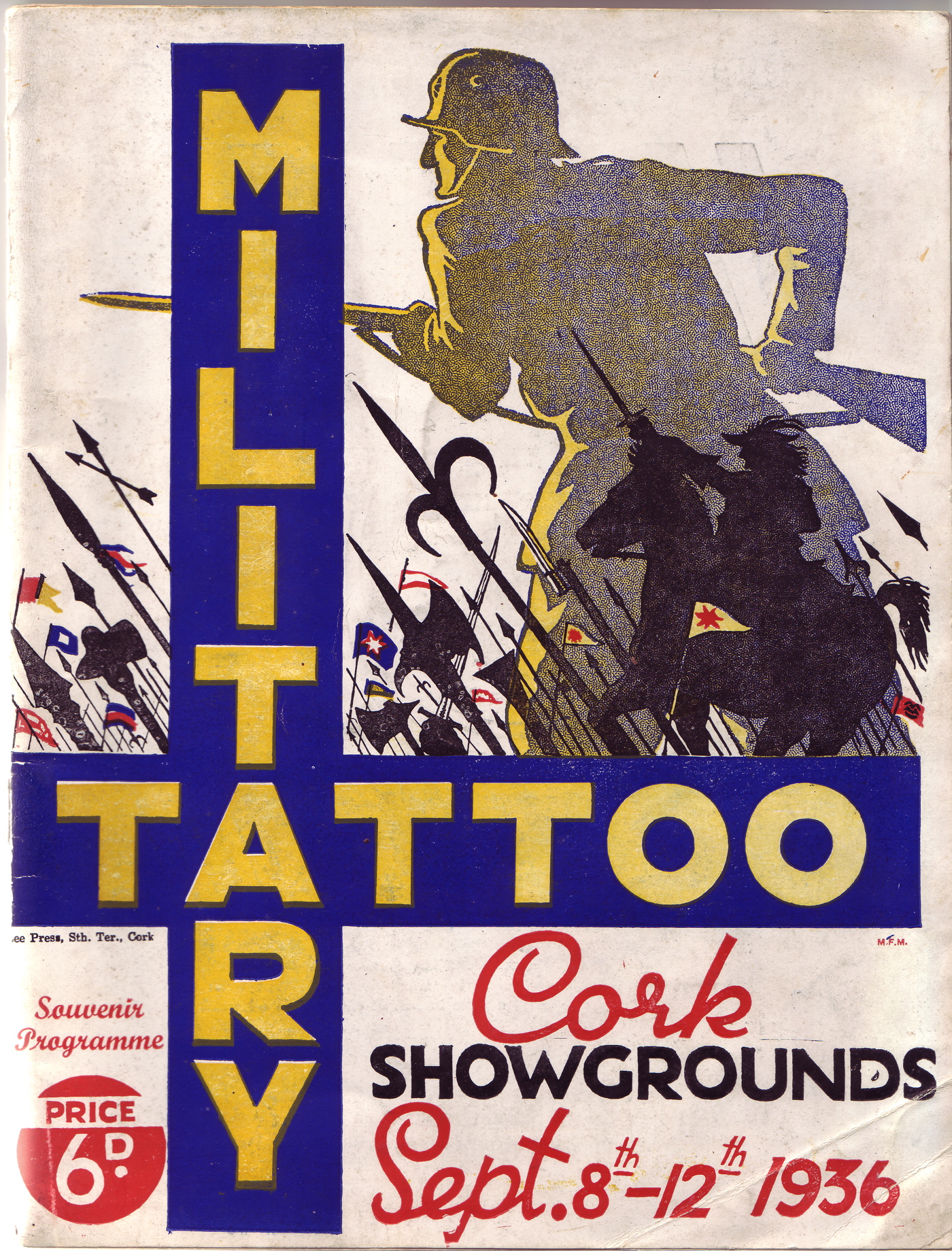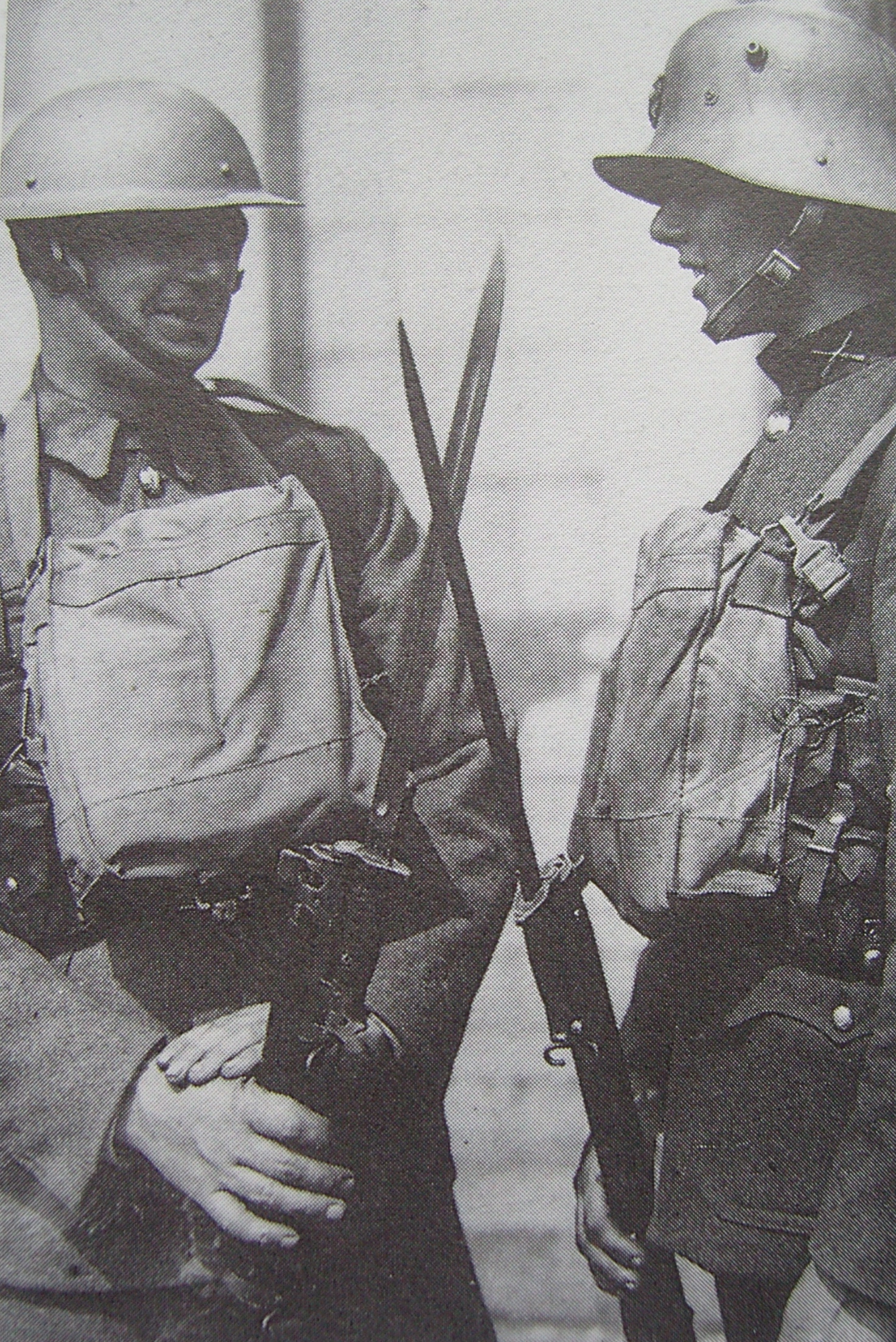
Mildly disorientated? This ‘German’ silhouette is an Irish soldier, depicted on the cover of the programme for the Irish army’s military tattoo in 1936. The Irish army battle dress until 1940 featured a German-style coal scuttle helmet.

Those who paid 6d for the programme in September 1936 couldn’t possibly imagine that the silhouette of a man in a coal-scuttle style helmet would become the twentieth-century’s visual shorthand for military terror.
Thus in 1936, Cork audiences enjoyed a dramatic military tattoo, featuring military bands, historical re-enactments, contemporary military drills and concluding with ‘The Rally of the Nation’. The three-hour programme provided ‘a constant contrast between the pageantry and glamour of the past, and the progress and efficiency of the present day’ 1

This military tattoo in Cork was a reprise of the successful event organised in Dublin a year earlier. Sadly, rehearsal footage from the Dublin Tattoo doesn’t show the grand spectacle of ‘The Ride to Ballyneety’, (from 1690) or the burning of GPO in Easter 1916, but the hazards of working with animals are illustrated in the opening minute of the film as an impatient soldier waits for a wolfhound to finish voiding its bowels.2 The costume design and dramatic elements of the tattoo had drawn in civilians such Micheál MacLiammor, of the Gaiety Theatre and amateur dramatic societies. 3 The army was keen to stress that historical accuracy was as important as dramatic effect. 4 The army’s stated aims in holding the Tattoo were ‘to impart a more correct knowledge of Irish military history’ 5 and to bring the army and people closer together 6 The public certainly enjoyed the event and it was estimated that 105,000 people attended over the five nights it was staged. 7 It was an impressive show, with soldiers in battery-lit caps performing intricate manouevres in the darkness, 8 the mechanised cavalry performing a version of the traditional, mounted ‘musical ride’ 9, and 2,500 performers assembled for the grand finale. 10 These features were repeated for Cork audiences in 1936.
But these tattoos were not the first performed by the Irish army. The Army staged its first tattoo during Dublin city’s Civic Week (15-24 September) in 1927. This event, held in Landsdowne Road rugby grounds, drew large crowds and considerable public appreciation. The Irish Independent described the ‘National Army’s Big Triumph’, as an especially impressive one because it was ‘a first attempt, devoid of precedents or traditions’. According to the paper, the audience was not very sympathetic, since the ‘great majority’ were merely curious, while ‘others were frankly sceptical’. In spite of cold winds and heavy rain the three-hour display of drilling, pageantry and spectacle impressed the 15,000 strong audience. 11 The tattoo raised the prestige of the state because ‘it showed astonished and delighted foreign visitors that the National Army can eclipse the exhibitions even of Wembley’. 12 This would have been an incredible feat given the comparative size of the Irish Army and dedication of the British army to pomp, ceremony, theatre and lavish uniforms. The Irish Army did not display cavalry or heavy artillery, apparently for fear of damaging the rugby pitch. 13 The cavalry had been central to the success of British military tattoos in the nineteenth century; 14 the improbable and intoxicating mix of cavalry and loud music charmed British audiences until 1999 in the Royal Tournament. 15 The newly formed Irish army had no mounted soldiers until 1931, when the ‘Blue Hussars’ were established.16 The Irish Independent‘s effusive praise hints at a sense of martial inferiority that was partly dispelled by the successful tattoo. What impressed the journalists most was the martial splendour on show, while the historical aspects of the military tattoo were largely ignored in press coverage of the 1927 event, possibly because there were historical pageants staged in the Mansion House and Trinity College that week. 17
The Army’s first tattoo was such a success that a similar version was staged in 1929, again for Dublin city’s Civic Week. This time, the historical pageantry on the programme drew more attention. There was an extra item in the programme, a reenactment of the Siege of Clonmel (1650), an incident championed as example of the heroic and apparently endless resistance of the Irish to British rule. Luckily, a Pathe camera captured this great piece of historical pageantry, where the Roundheads are comprehensively beaten by troops defending the town of Clonmel. 18 Of course, Cromwell’s forces ultimately prevailed in Ireland, but it is hardly surprising that the army preferred to focus on the successes of men that they believed were their direct predecessors.
It is hard to judge what the public thought about these military tattoos but they certainly attended in large numbers. Cork audiences applauded particularly enthusiastically at the re-enactment of the 1916 Rising and broke into ‘loud cheering’ when the Irish flag was raised. 19 The audience of children at the matinee performance in 1935 were ‘intensely interested’ in the historical pageants but also reacted well to the Irish-language commands. While the shows were popular in Cork and Dublin their impact outside of these cities was limited. The local newspapers for other counties searchable in the Irish Newspaper Archive do not mention the military tattoos. Of course, national newspapers such as the Irish Independent and the Irish Press were widely read all over the country, but the Dublin focus of these publications was obvious to newspaper readers in provincial Ireland. Thus the army’s efforts to publicise both itself and its vision of martial history made the greatest impact on the audiences of urban-dwellers who witnessed it.
***Many thanks to Dr Clodagh Tait, whose donation of the Cork Military Tattoo programme made this blogpost possible!***
- ‘Children’s Evening’, Irish Independent, 11 Sept 1935, p 11. ↩
- http://www.britishpathe.com/video/irish-military-tattoo Accessed 14 June 2012. ↩
- ‘Engineers hard at work on construction of scenes’ Irish Press, 28 August 1935, p 2; the Protobello Dramatic Club were mostly related to, or friendly with soldiers in barracks, ‘Civilian’s part in Tattoo’, Irish Press, 13 Sep 1935, p 8. ↩
- ‘2000 Years of Military History’, Irish Independent, 14 August 1935, p 6. ↩
- ‘Sarsfield’s Epic Ride’, Irish Press, 12 Sept 1935, p 8. ↩
- ‘Military Tattoo Closes’, Irish Independent, 23 Sep 1935, p 2 ↩
- ‘Military Tattoo Closes’, Irish Independent, 23 September 1935, p 2 ↩
- ‘Engineers hard at work on construction of scenes’ Irish Press, 28 August 1935, p 2 ↩
- ‘Military Tattoo’, Irish Press, 18 Sept 1935, p 1 ↩
- ‘2,000 Years of Military History’ Irish Independent, 14 August 1935, p 6 ↩
- ‘National Army’s Big Triumph’, Irish Independent, 19 September 1927, p 10. ↩
- ‘A Fine Opening’, Irish Independent, 19 September 1927, p 6. ↩
- ‘National Army’s Big Triumph’, Irish Independent, 19 September 1927, p 10. ↩
- Jeffrey Richards, Imperialism and Music: Britain 1876-1953 (2001), p 212. ↩
- http://www.royaltournament.org/, Accessed 14 June 2012. ↩
- http://multitext.ucc.ie/d/The_Cavalry_Guard_of_the_Irish_Army_the_Blue_Hussars Accessed 14 June 2012. ↩
- ‘Pageants of History’ Irish Independent, 26 Sept 1926, p 8. ↩
- http://www.britishpathe.com/video/irish-military-tattoo-1, Accessed 14 June 2012. ↩
- Historic Scenes Re-Enacted Irish Press, 9 September 1936, p 9. ↩